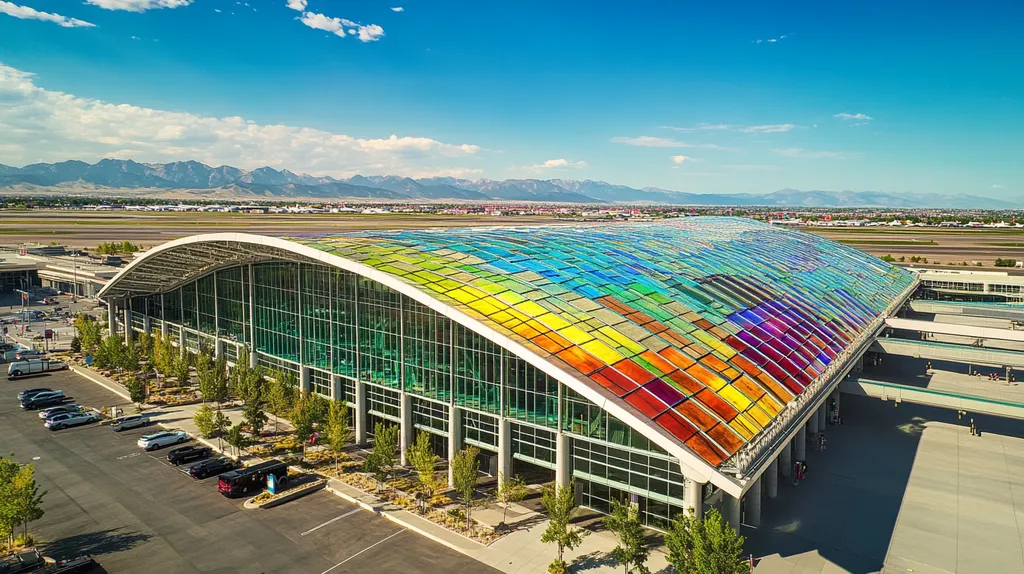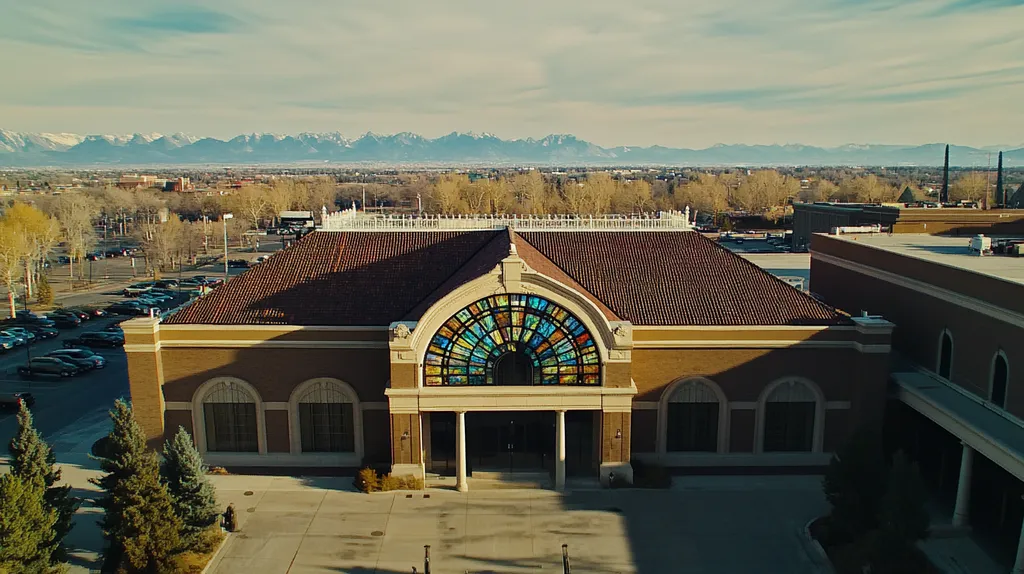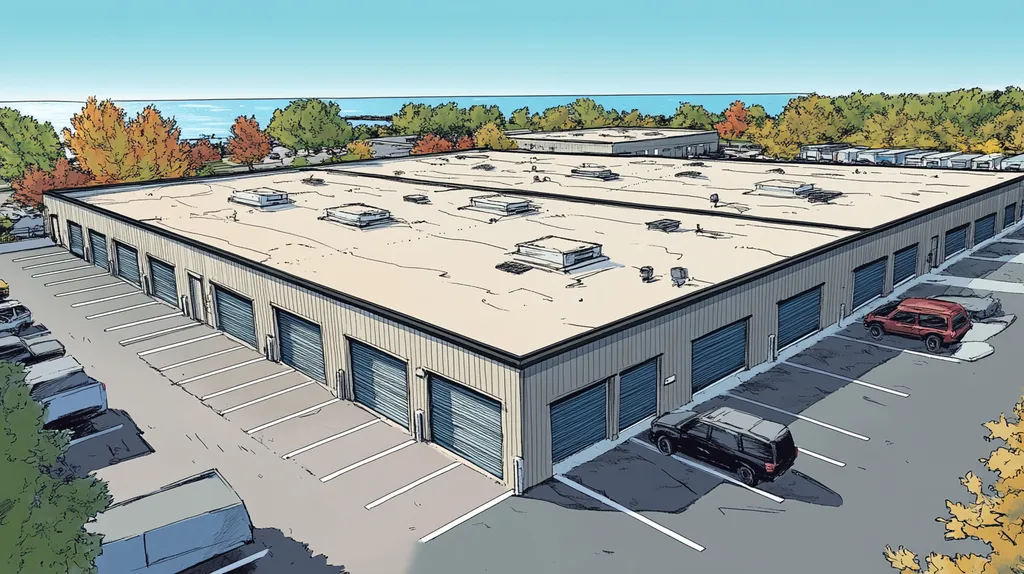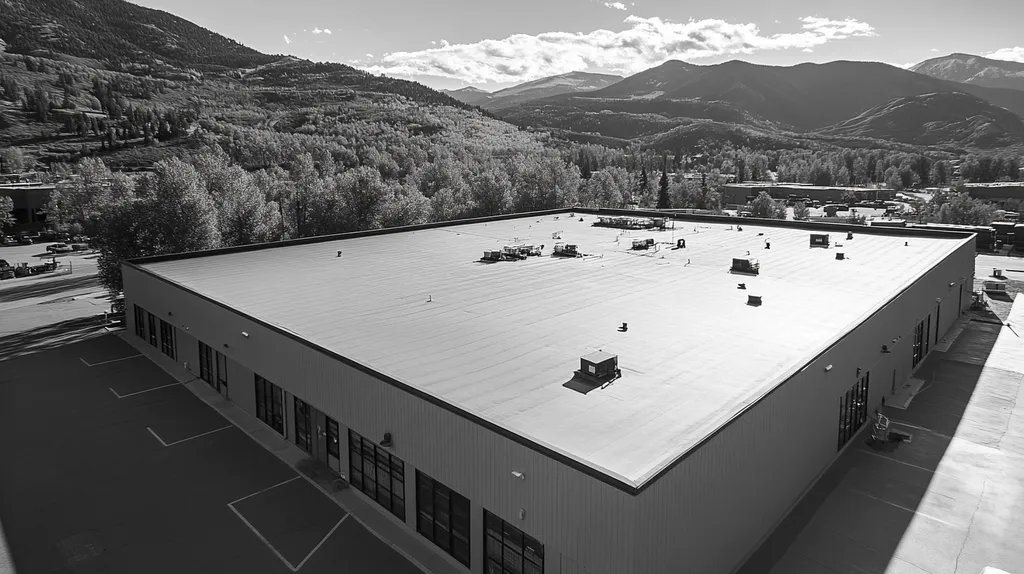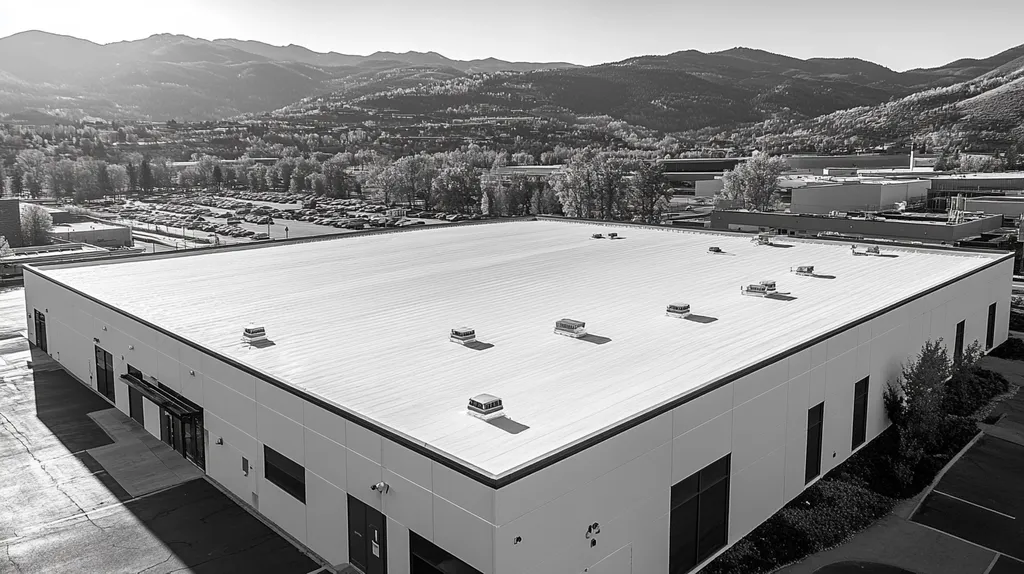Welcome to today’s Battle Royale featuring two roofing heavyweights: “TPO” in the east corner versus “EPDM” in the west!
Tonight’s showdown pits these contenders against each other across six punishing rounds designed to test every aspect of their performance for zoning laws on industrial roofs.
At stake? Millions in potential costs, decades of building protection, and the critical performance demands of modern commercial and industrial facilities.
Our professional judging panel will evaluate each round on technical merit, real-world performance, and value delivery. After all six rounds, we’ll declare our ultimate champion.
Ladies and gentlemen, facility managers and building owners… it’s time to rumble!
ROUND 1: INITIAL COSTS & INSTALLATION
When choosing a roofing system for an industrial facility, the initial investment can make or break your budget. With increasingly complex zoning regulations affecting material choices and installation requirements, the stakes are higher than ever for facility managers weighing TPO against EPDM options.
Understanding how these systems compare in terms of upfront costs, installation requirements, and project timelines is crucial – especially when local zoning laws can impact everything from material specifications to construction schedules.
Material Expenses
The raw material costs between TPO and EPDM create the first major decision point for facility managers. TPO typically runs 15-25% higher per square foot than EPDM, primarily due to its more complex manufacturing process and enhanced reflective properties.
Local zoning laws can magnify this cost difference, particularly in areas requiring specific energy efficiency ratings or solar reflectance values. TPO naturally meets many of these requirements but at a premium price point, while EPDM may need additional treatments or coatings to comply.
While both materials are readily available, EPDM’s simpler composition and manufacturing process keeps costs lower even when meeting zoning requirements. For pure material expenses, EPDM claims the “ADVANTAGE” in most scenarios.
Installation Complexity
Installation procedures vary significantly between these systems, with major implications for labor costs and project coordination. TPO requires specialized welding equipment and highly trained installers to ensure proper seam fusion and long-term performance.
EPDM installation involves simpler adhesive-based techniques that more roofing crews are experienced with. This broader installer availability typically translates to more competitive labor rates and easier scheduling.
When factoring in zoning compliance inspections and documentation requirements, EPDM’s straightforward installation process proves advantageous. The simpler technique means fewer potential compliance issues and inspection points, giving EPDM the clear “ADVANTAGE” for installation complexity.
Project Timeline
Time is money in industrial roofing, especially when zoning regulations restrict construction hours or impose strict completion deadlines. TPO installation requires precise temperature and weather conditions for proper seam welding, which can extend project timelines unpredictably.
EPDM offers more flexibility in installation conditions and can often be applied in a wider range of temperatures. This adaptability helps maintain project momentum even when working around zoning-mandated construction restrictions.
The faster installation time and fewer weather-related delays make EPDM the more reliable choice for meeting strict zoning timeline requirements, earning it another “ADVANTAGE” in this category.
ROUND 1 WINNER: EPDM
ROUND 2: DURABILITY & LIFESPAN
When industrial facilities face strict zoning requirements, the durability and lifespan of roofing materials become critical decision factors. Local regulations increasingly mandate minimum performance standards for commercial roofs, affecting everything from material selection to replacement schedules.
Understanding how TPO and EPDM systems perform over time isn’t just about maintenance costs – it’s about maintaining continuous compliance with evolving zoning standards. Navigating these requirements while ensuring optimal roof performance requires careful consideration of each material’s long-term characteristics.
Environmental Resistance
Local zoning laws increasingly specify minimum requirements for UV resistance, wind uplift ratings, and thermal performance. TPO’s inherent reflective properties and strong heat resistance make it naturally compliant with many of these regulations without additional modifications.
EPDM requires additional treatments or coatings to achieve similar reflective properties, though it excels naturally in thermal stability. While both materials can meet most environmental requirements, TPO’s built-in properties give it the ADVANTAGE for regulatory compliance.
Material Longevity
Zoning codes often dictate minimum expected lifespans for commercial roofing systems. TPO roofs typically last 20-25 years when properly installed and maintained, aligning well with most commercial building codes.
EPDM systems demonstrate remarkable longevity, frequently lasting 25-30 years under proper maintenance. This extended lifespan often exceeds minimum zoning requirements, giving EPDM the ADVANTAGE in this category.
Maintenance Requirements
Zoning regulations frequently mandate regular roof inspections and maintenance programs. TPO’s heat-welded seams create a monolithic surface that simplifies inspections and reduces maintenance points that require monitoring for compliance.
EPDM’s fewer seams and simple repair procedures make it easier to maintain compliance with inspection requirements. However, its darker surface can make damage detection more challenging during mandated inspections.
TPO’s easier inspection process and clearly visible surface conditions give it the ADVANTAGE for ongoing compliance monitoring.
ROUND 2 WINNER: TPO
ROUND 3: PERFORMANCE FACTORS
Performance factors in industrial roofing have become increasingly critical as zoning laws evolve to address climate change and urban development concerns. Property owners must navigate a complex web of regulations affecting everything from material choices to energy efficiency requirements.
Understanding how TPO and EPDM perform under these regulatory pressures can mean the difference between a compliant, efficient facility and one facing costly retrofits or penalties.
Energy Efficiency and Compliance
Modern zoning regulations increasingly emphasize energy performance, making roofing choices more critical than ever. TPO’s highly reflective surface naturally meets or exceeds most energy code requirements without modification, potentially reducing cooling costs by up to 30% in warm climates.
EPDM requires additional coatings or modifications to achieve similar reflective properties, though it performs well in colder regions. However, these modifications can affect warranty coverage and increase maintenance requirements.
With more jurisdictions adopting strict energy efficiency standards, TPO’s inherent reflective properties give it a clear ADVANTAGE in this category.
Weather Resistance and Durability
Zoning laws often include restrictions on the density and height of structures, which can directly affect the scope of roofing repairs and maintenance requirements. TPO demonstrates excellent resistance to UV radiation and chemical exposure, maintaining its protective properties longer in demanding industrial environments. (source: WWRL 1600)
EPDM shows superior flexibility and crack resistance, particularly important in areas with extreme temperature fluctuations. Its elastic properties allow it to expand and contract without compromising structural integrity.
Both materials offer comparable weather resistance under most conditions, resulting in a TIE for this category.
Chemical and Fire Resistance
Industrial zoning requirements often specify minimum standards for chemical and fire resistance, particularly in manufacturing districts. TPO’s formulation provides excellent resistance to common industrial chemicals and meets Class A fire ratings without additional treatment.
EPDM offers good chemical resistance but may require additional fire-retardant treatments to meet stricter zoning requirements. These treatments can increase costs and complicate future repairs or modifications.
TPO’s superior baseline performance in both chemical and fire resistance gives it the ADVANTAGE in this category.
ROUND 3 WINNER: TPO
ROUND 4: MAINTENANCE REQUIREMENTS
As zoning regulations become increasingly stringent, maintenance requirements for industrial roofs have evolved beyond simple repairs into complex compliance matters. Property owners must now balance routine upkeep with strict regulatory standards that can impact everything from inspection schedules to repair protocols.
Making the wrong choice between TPO and EPDM can lead to significant maintenance challenges, especially when local zoning laws dictate specific upkeep requirements and documentation standards.
Inspection and Documentation Requirements
TPO roofs feature highly visible white or light-colored surfaces that make inspections straightforward and efficient. Their reflective properties not only contribute to energy efficiency but also make damage detection simpler during mandatory zoning inspections. (source: Baroofings)
EPDM’s darker surface can complicate visual inspections, requiring more time and specialized equipment to identify potential issues. This increased inspection complexity can lead to higher costs and more extensive documentation requirements.
The ease of inspection and clear visibility of damage gives TPO the ADVANTAGE in meeting zoning-mandated inspection protocols.
Repair Protocols
When repairs become necessary, TPO systems often require specialized welding equipment and certified technicians to maintain warranty compliance. However, these repairs typically create seamless fixes that fully restore the roof’s protective properties.
EPDM repairs rely on adhesive-based methods that more contractors can perform, though achieving proper adhesion can be challenging in certain weather conditions. The simpler repair process makes it easier to maintain compliance with zoning-mandated repair timeframes.
Given the broader availability of qualified repair contractors and simpler procedures, EPDM claims the ADVANTAGE for repair protocols.
Long-term Maintenance Planning
TPO roofing systems benefit from predictable maintenance schedules that align well with zoning-required facility maintenance plans. Their consistent performance characteristics make it easier to develop long-term maintenance strategies that satisfy regulatory requirements.
EPDM systems may require more frequent adjustments to maintenance plans as the material ages, particularly in regions with strict energy efficiency standards. This can complicate compliance with fixed maintenance schedules mandated by local regulations.
The predictability and consistency of TPO maintenance requirements earn it the ADVANTAGE in this category.
ROUND 4 WINNER: TPO
ROUND 5: SUSTAINABILITY CREDENTIALS
As zoning laws increasingly mandate sustainable building practices, industrial facility managers face mounting pressure to balance environmental compliance with operational efficiency. Modern regulations are reshaping how we evaluate roofing materials, with some jurisdictions requiring specific sustainability metrics for permit approval.
Understanding how TPO and EPDM align with these evolving requirements has become crucial for avoiding costly penalties and ensuring long-term compliance with local sustainability ordinances.
Environmental Impact Assessment
Navigating zoning laws in commercial roofing requires careful consideration of environmental impact factors, particularly as regulations become more stringent around sustainable building practices. (source: H Proofing Pro)
TPO membranes are manufactured using environmentally conscious processes that produce fewer harmful emissions. Their production requires less energy than traditional roofing materials, and many TPO products incorporate recycled materials without compromising performance.
EPDM manufacturing generates more emissions and requires more energy input, though the material itself is inert and poses minimal environmental risk once installed. However, its production process often struggles to meet stricter zoning requirements for sustainable manufacturing.
TPO’s cleaner manufacturing process and use of recycled content gives it the ADVANTAGE in this category.
Energy Performance Standards
Modern zoning codes increasingly specify minimum energy performance standards for commercial roofing systems. TPO’s highly reflective surface naturally meets or exceeds most energy code requirements without modification, potentially reducing cooling loads by 25-35% in warm climates.
EPDM’s dark surface absorbs more heat, which can increase cooling costs and strain HVAC systems. While white EPDM options exist, they typically require additional coatings that can wear down over time, compromising long-term energy performance.
The superior energy performance and natural reflectivity of TPO earns it another clear ADVANTAGE in meeting sustainability requirements.
End-of-Life Management
As municipalities tighten restrictions on construction waste disposal, end-of-life management has become a critical consideration. TPO membranes can be fully recycled into new roofing materials, reducing landfill impact and meeting increasingly common waste reduction requirements.
EPDM also offers recycling potential but requires more complex processing due to its chemical composition. Many facilities find EPDM recycling options limited by local availability of specialized recycling services.
While both materials can be recycled, TPO’s more straightforward recycling process and wider acceptance at recycling facilities gives it the ADVANTAGE.
ROUND 5 WINNER: TPO
ROUND 6: SPECIALIZED APPLICATIONS
Industrial roofing decisions have become increasingly complex as zoning laws evolve to address specialized applications and unique building requirements. With some jurisdictions now mandating specific roofing solutions for different building types, the stakes are higher than ever for facility managers selecting between TPO and EPDM systems.
Understanding how these materials perform in specialized contexts while maintaining zoning compliance can mean the difference between a successful installation and costly modifications or replacements.
Industrial Process Compatibility
Many industrial facilities must balance their manufacturing processes with roofing requirements specified by local zoning codes. TPO membranes demonstrate excellent resistance to chemical exposure and industrial emissions, maintaining their protective properties even in harsh manufacturing environments.
EPDM shows similar chemical resistance but may require additional protective coatings in facilities with heavy industrial emissions. These coatings can affect the material’s flexibility and potentially complicate zoning compliance over time.
For industrial process compatibility while maintaining zoning compliance, TPO claims the ADVANTAGE.
Specialized Equipment Integration
Modern industrial facilities often need to integrate rooftop equipment while adhering to strict zoning height restrictions and setback requirements. TPO’s heat-welded seams create a monolithic surface that simplifies the installation of equipment supports and penetrations.
EPDM’s adhesive-based installation can make equipment integration more challenging, particularly when meeting specific zoning requirements for equipment screening and access points. While both materials can accommodate equipment, TPO’s installation method provides better long-term integrity around penetrations.
The superior integration capabilities and maintained compliance give TPO the ADVANTAGE in this category.
Expansion and Modification Requirements
Zoning laws increasingly affect how industrial facilities can expand or modify their structures over time. TPO systems can be readily modified and expanded while maintaining their original performance characteristics, making future changes more straightforward when allowed by zoning codes. (source: WWRL 1600)
EPDM requires careful attention during modifications to maintain proper sealing and avoid compromising the membrane. While EPDM can accommodate changes, achieving consistent results with additions or modifications proves more challenging under strict zoning oversight.
TPO’s adaptability to modification while maintaining zoning compliance earns it the ADVANTAGE.
ROUND 6 WINNER: TPO
AND THE WINNER IS…
After six grueling rounds of technical evaluation, we have our verdict! With a commanding 5-1 victory, TPO emerges as our undisputed champion in the battle of industrial roofing supremacy under modern zoning requirements!
TPO dominated the competition with superior performance in durability, maintenance protocols, sustainability credentials, and specialized applications. Its natural reflectivity, easier inspection process, and stellar environmental impact assessment delivered knockout blows across multiple rounds.
But don’t count EPDM out entirely! This veteran contender proved its worth in Round 1, demonstrating superior cost-effectiveness and simpler installation requirements. For facilities in colder climates or working with tight initial budgets, EPDM remains a formidable challenger.
IMPORTANT NOTICE: Every facility faces unique challenges that can impact roofing performance. Local climate conditions, specific building requirements, and regional zoning regulations all play crucial roles in determining the optimal roofing solution. This analysis provides general guidance but cannot account for all variables. Always consult with qualified roofing professionals who can evaluate your specific situation before making a final decision.
Ladies and gentlemen, in the high-stakes arena of industrial roofing, remember: The true champion isn’t just the material with the most technical victories – it’s the one that best matches your facility’s specific needs while maintaining compliance with local regulations. Choose wisely!
FREQUENTLY ASKED QUESTIONS
Q. How do zoning laws affect commercial roof installation costs?
A. Zoning laws can increase commercial roof installation costs due to specific material requirements and compliance inspections. For instance, TPO may cost more initially than EPDM due to its advanced properties and potential energy efficiency certifications. Understanding these legal requirements upfront can prevent budget overruns during installation.
Q. Which material lasts longer for industrial roofs under zoning laws?
A. EPDM roofs typically last longer than TPO, often spanning 25-30 years compared to TPO’s 20-25 years. However, local zoning laws may influence maintenance requirements and inspections, impacting the longevity of both materials. Choosing the right option depends on aligning with local environmental standards and long-term performance expectations.
Q. What are the performance factors for commercial roofs under zoning laws?
A. Performance factors such as energy efficiency and weather resilience are crucial when selecting commercial roofs under zoning laws. TPO roofs are generally more efficient due to their reflective surfaces, potentially reducing cooling costs. Understanding these factors can help you remain compliant while ensuring optimal performance for your facility.
Q. What maintenance is required for industrial roofs due to zoning regulations?
A. Maintenance for industrial roofs is often dictated by local zoning regulations, including regular inspections and detailed documentation. TPO roofs are easier to inspect and maintain, thanks to their visible surfaces, while EPDM might require more effort to monitor for damage during inspections. Staying compliant with maintenance schedules helps avoid costly fines.
Q. How do zoning laws impact sustainability for commercial roofs?
A. Zoning laws increasingly emphasize sustainability, requiring materials with low environmental impact and high energy efficiency. TPO roofs often meet these demands better than EPDM due to their manufacturing processes and recyclability. Selecting a sustainable roofing option is essential to comply with evolving local regulations and reduce operational costs.
Q. What are specialized applications of TPO and EPDM roofs under zoning laws?
A. Specialized applications may require compliance with specific zoning laws that dictate the roofing materials used. TPO is often preferred in industrial settings due to its chemical resistance and seamless installation foundation, making it suitable for equipment integration and future modifications. Understanding local law requirements can ensure the right choice for your roofing needs.
Q. What financing options should I consider for a new industrial roof?
A. Financing options for an industrial roof can include loans, leases, or grants available for upgrades complying with zoning laws. Many institutions offer specialized financing to encourage energy-efficient and sustainable roofing practices. Exploring diverse financing avenues can help you manage upfront costs while meeting regulatory requirements.

